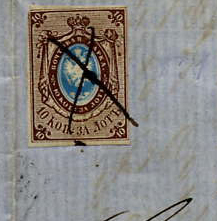Pen cancel



In philately, a pen cancel – symbol ⟨![]() ⟩[1] – is a cancellation of a postage or revenue stamp by the use of a pen, marker or crayon.
⟩[1] – is a cancellation of a postage or revenue stamp by the use of a pen, marker or crayon.
Usage
[edit]In the early days of stamps, cancellation with a pen was common. Today stamps are almost always cancelled with an inked handstamp or a machine cancel as this is quicker to apply. Pen cancels are still sometimes seen today when a postal official needs to cancel stamps missed by the automatic cancelling machine.
There are no fixed terms for the different types of pen cancels, but a cancel in the form of two crossed lines has been referred to as an X cancel.[2] Pen cancels may also take the form of notations by the canceller,[3] the city in which the item was posted or the initials of the local postmaster.
A pen cancel may indicate fiscal (revenue) use; however, in the early days of stamps a pen cancel was sometimes used because no handstamp was available, for instance in Nicaragua where pen cancels were used for seven years after their first stamps appeared in 1862.[4]
Values
[edit]A used postage stamp with a pen cancel is usually worth much less than a stamp cancelled using a handstamp or machine.[5] In particular, the additional information from the handstamp is lost and the pen cancel may indicate fiscal (revenue) rather than postal use. Pen cancelling is, however, a common method of cancelling stamps used fiscally. Stamps marked valid for both postage and revenue use are usually worth less when fiscally used.
Tampering
[edit]Some people have attempted to remove pen cancels from used stamps in order to make them appear as more valuable mint stamps.
References
[edit]- ^ Michel (2007) Übersee-Katalog. Band 1/1 Nordamerika 2007/2008. Unterschleissheim Schwaneberger, p. 18.
- ^ X is for X-cancel alphabetilately.org
- ^ "Covers from the Postmark Collectors Club Website". Postmarks.org. Retrieved 2008-11-28.
- ^ Sutton, R.J. & K.W. Anthony. The Stamp Collector's Encyclopaedia, Stanley Paul, London, 1966, p.226.
- ^ "Grading Guide - Eye Appeal". Professional Stamp Experts. Retrieved 2008-11-28.
External links
[edit]Text is available under the CC BY-SA 4.0 license; additional terms may apply.
Images, videos and audio are available under their respective licenses.
